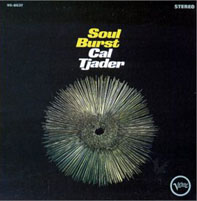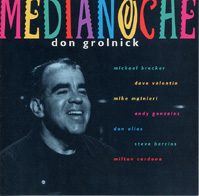

|
Soundclip:
|
| See Steve's Hand-Written Solo
Transcription |
Michael
Brecker's Tenor Sax solo on:
"Oran"(Chick Corea) With the presentation of this 5th transcription, we complete our series of Michael Brecker tenor sax solos from Don Grolnick's wonderful "MEDIANOCHE," recording.  How well I remember the Chick Corea composition,
"Oran," from Cal Tjader's "SOUL BURST" because it was, without question, the most adventurous writing on that milestone record in Latin Jazz history. Like most creative pieces, the producer Creed Taylor had it carefully
"hidden" as Trk. [9](or, as it was in those days, the 4th cut on Side 2 of the LP). It is rather
ironic that on Don's CD "Oran" also appears in the 9th slot, but I'm certain that he was not
"hiding" the tune. How well I remember the Chick Corea composition,
"Oran," from Cal Tjader's "SOUL BURST" because it was, without question, the most adventurous writing on that milestone record in Latin Jazz history. Like most creative pieces, the producer Creed Taylor had it carefully
"hidden" as Trk. [9](or, as it was in those days, the 4th cut on Side 2 of the LP). It is rather
ironic that on Don's CD "Oran" also appears in the 9th slot, but I'm certain that he was not
"hiding" the tune.For those of you who are coming to these pages for the first time, you might want to read what I've written as background information for the prior solos shared here, which included: "Rainsville"; "Rojo y Negro"; "If Ever I Should Leave You"; and most recently, "Cape Verdean Blues" from that same recording. Those of you who have been visiting the site specifically for these solos, you can probably just skip the following paragraph. In 1995, my dear friend, pianist/composer/arranger Don Grolnick recorded his final CD "MEDIANOCHE" which was eventually picked-up and released by Warner Bros. Sadly, it was not too long after that, we all lost Don to a battle with lymphoma. To this day, Don is missed tremendously by his family, friends, and by all those who loved his playing and compositions. Don and I were close friends and musical associates for nearly 30 yrs. and, in some small way, I feel like I had a hand in this recording. You see, it was many years before when I gave Don my 'extra' LP copy of Cal Tjader's recording, "SOUL BURST," which features some brilliant playing by Chick Corea. Don always loved this recording and when he decided to explore the world of Latin jazz, this recording, its feel, its attitude and even many of its tunes became the model for the band he assembled. A band which included longtime colleagues like Michael Brecker, Mike Mainieri, Don Alias and, from the Latin world, Dave Valentín, Andy González, Milton Cardona, and Steve Berrios.For the purposes of this transcription, I decided to write out the solo in 4/4 as opposed to "cut-time," which would be normal for most Latin charts. I just felt that it would look best, and read best if it was written out this way. "Oran" is a fascinating composition, especially in a Latin context because, though it has 28 bars in total, the actual phrases would seem to be inclined to "break" the clave. One could view the piece as having two sections, I could have labeled them as [A] and [A2], with [A] having 15 bars and [A2] having 13 bars which is really strange. What contributes to this odd number of bars is the insertion of the one bar of G7(alt.), which appears in bar 5 of each section. However, it must be restated that almost all double-time, fast, Latin tunes are written in cut-time, and so, if one views the form in that way, [A] would have 30 bars, and [A2] would have 26 bars. In this way, it might only 'feel' harmonically strange in the aforementioned locations. It should also be noted that, like most of the solo transcriptions shared here, this is written in concert key, but it is written in the register of the guitar which means that it is written one octave above where it actually would sound on a piano. So, always keep that in mind!!! The piece is played at a rapid clip, in a 3:2 Rumba clave and is anchored by the relentless Latin Jazz "Mambo" rhythms supplied by Andy, Milton, Don and Steve. My dear friend, saxophonist/arranger, Rafael Greco advises me that Milton is actually playing a "Guaguancó" pattern on the congas. For this recorded version, Don's arrangement features solos from the entire front line. And, Mike Brecker is 3rd in line following directly on the heels of Mike Mainieri's vibes solo. As is very traditional in our music, Mike Brecker chooses to pick up a fragment from Mainieri's last phrase, and employs it as the point-of-departure for his own improvisation. The first 4 bars of Gm7 are based around his usage of the G minor pentatonic scale(G, Bb, C, D, F), with five descending crisp phrases all beginning on the root. In bar 5, to acknowledge the arrival of the G7(alt.) chord, Mike outlines a G7(b9, b5) of Db/G sound. As the Cm7 chord arrives, the tune almost has the feel of a minor blues, as the i chord passes to the iv chord. Though this should be approached as a C Dorian area(C, D, Eb, F, G, A, Bb), you can see that here, Mike has chosen to outline three separate triads from within the mode: an F triad, a C minor triad, and then a Bb triad. Then, with an emphasis placed on a high Bb(#5), Mike employs the D altered dominant scale(D, Eb, F, F#, Ab, Bb, C), but his approach gives it a particularly angular feel as the chord moves to a false cadence of Ebmaj7(9). In the 3rd bar of this phrase, he briefly employs the D minor pentatonic(D, F, G, A, C) which immediately supplies the sound of the #4(A), and then the phrase closes with the full Eb Lydian mode(Eb, F, G, A, Bb, C, D). The descending line, which begins in bar 10, offers what I would refer to as a Wayne Shorter-ism because of the rhythmic groupings. [Note: If you have been studying your Miles Davis Quintet recordings from the mid-'60s, you would recognize the similarities.] Also, if you examine the emotional content of the important notes during bars 8-11, Mike places his emphasis on the important chordal color tones, which begin with the 5th(Bb) and lead to the "extensions": 6th(C), maj7th(D) and 9th(F). Though the flurry of 16th notes in bars 12-15 is played with fire and speed, if one breaks it all down into smaller units perhaps one can see the "thinking" process behind these sounds over a D7(alt.) chord. Firstly, Mike outlines an Ab triad, and then appears to be in Bb area. To my way of thinking, this is as if he utilizing the Bb dominant 7th pentatonic(Bb, C, D, F, Ab) which gives you three of the altered tones: Bb(#5); F(#9); and Ab(b5). In bar 13, Mike passes over a descending diminished or 13b9 sequence[D-B-F#-F to B-Ab-Eb]. What's interesting about this is that normally this is not something you would want to play over a V7(alt.) when it is going to a minor resolution!!! But here, in this case, it's in the middle of a phrase, and it is played so rapidly that you don't notice the B-natural too much. And this would surely be the "problem" note as you are resolving to Gm7 which contains a Bb. It might also serve you well to observe the small chromatic grouping of F-E-Eb-F-F# which appears three times during the course of the long line. As the 2nd half of the solo chorus begins, in bars 16-17 Mike finds himself using the romantic interval of the 6th with D to Bb, E up to C, and back to D to Bb. In bars 17-18, as his line descends, there is a reprise of the little Wayne Shorter-ism. Again, note the rhythmic groupings of an 8th-note and two 16th-notes. As the G7(alt.) chord again arrives, at bar 20, Mike anticipates its arrival with a classic and simple configuration of pitches: G-Ab-B-natural-D which tend to outline a G7(b9) sound as he vaults to the upper register of the tenor saxophone and plays his high Bb, which is the #9 of the chord. This same pitch, the #9, again played in the upper register, is used for emotional emphasis as bar 22 and the D7(alt.) chord arrives.  From that high 'F' Mike then
descends using basic elements from the b9/b5 chordal sounds. So in this harmonic area you see Eb and Ab. In bars 23-24, as the harmony makes its most active movements, two chords per bar, he, in essence, ignores the A7(alt.) chord, and anticipates the arrival of next D7(alt.) sound. This is also a most common device and enables players to give flow to their lines and improvisations as they float over the bar lines. As the E7(alt.) chord arrives in the last half of bar 24, Mike employs the E altered dominant scale(E, F, G, G#, Bb, C, D) which is also thought of as F melodic minor(F, G, Ab, Bb, C, D, E) to make a smooth transition to Am7 with a C-natural played right on the downbeat of bar 25. Then, utilizing fragments of the A minor pentatonic(A, C, D, E, G), he reprises elements of how this solo began. Again, notice the similarities in the rhythmic groupings to what he played in bars 1-4. From that high 'F' Mike then
descends using basic elements from the b9/b5 chordal sounds. So in this harmonic area you see Eb and Ab. In bars 23-24, as the harmony makes its most active movements, two chords per bar, he, in essence, ignores the A7(alt.) chord, and anticipates the arrival of next D7(alt.) sound. This is also a most common device and enables players to give flow to their lines and improvisations as they float over the bar lines. As the E7(alt.) chord arrives in the last half of bar 24, Mike employs the E altered dominant scale(E, F, G, G#, Bb, C, D) which is also thought of as F melodic minor(F, G, Ab, Bb, C, D, E) to make a smooth transition to Am7 with a C-natural played right on the downbeat of bar 25. Then, utilizing fragments of the A minor pentatonic(A, C, D, E, G), he reprises elements of how this solo began. Again, notice the similarities in the rhythmic groupings to what he played in bars 1-4.The solo concludes on an Abmaj7(#4) sound, and here, one would normally expect to see the Ab Lydian mode(Ab, Bb, C, D, Eb, F, G) employed. Often times, an excellent linear device to get to the 'heart' of this sound is to utilize the G minor pentatonic(G, Bb, C, D, F) which directly avoids any usage of the root(Ab). But, as this solo must unwind rather quickly, and perhaps a bit awkwardly, Mike finds himself touching upon Ab a couple of times during bars 27-28. He even glances over a sense of Ab Lydian Augmented(Ab, Bb, C, D, E, F, G) by employing an E-natural as part of the ascending line in bar 27. It has truly been a great pleasure for us to present these five Michael Brecker tenor sax solo transcriptions here at KHAN'S KORNER 1. It was always our hope that sharing the written music along with some analysis would be of great assistance to the most serious of music students, young and old, who continually visit these pages. With another winter coming to a close, we want to wish everyone the beautiful things which seem to come with the renewal only springtime can bring. |